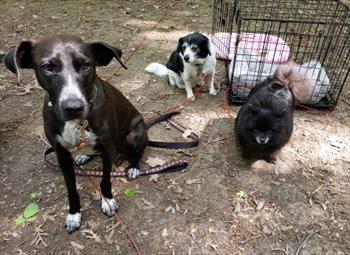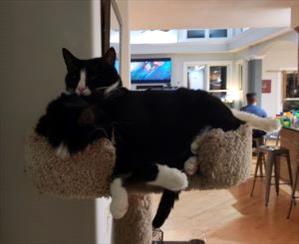Tony Johnson's foster dog and 2 dog

Left to right, Juniper the foster dog, Dax, and Turley. Photo by Dr. Tony Johnson.
I am lucky enough to have a peaceful coexistence among all the various pets in my home, for the most part.
Our current lineup is:
- 4 dogs: A wee Pomeranian (Turley), a pit bull (Gwen), a Beagle cross (Dax), and a foster dog (Juniper) who is sort of Lab-ish. The pit and the foster play and make out all day while the Pom and the beagle mix watch from the bleachers, silently judging and munching popcorn.
- 2 cats: Joseph and Jenx are tuxedo cat brothers who are foster failures. We bottle-fed them and then decided to add them to our family. They are wonderful and only get up to chaotic cat antics every now and again.
- 2 parakeets: They can't be bothered with human contact as they are too busy spreading their food and feathers everywhere and pooping on literally everything.
- 4 guinea pigs: One of them is blind from cataracts and I am considering getting her a seeing-eye hamster.
We've had a few negative interactions over the years,lungs but never any huge problems (except for that one time the otherwise pacifist cats reduced our bird population from three to two, but that was my fault for leaving the cage open). When the foster dog, Juniper - known to her friends as Junie - entered our home a few weeks ago, the balance of power was temporarily upset and a brief skirmish ensued that resulted in the beagle mix, Dax, having a small hole inserted in his skin. It healed without needing anything more than a cleaning, and the dogs have settled on a new power structure, so no more fights.
Not everyone is as lucky. As an ER vet, I see tons of negative pet interactions. Many end up like Dax: pride wounded, but little damage. Dogs have a way of communicating during a fight that the outcome is already decided, so it doesn't get too violent. But not always: if both parties feel they have the upper hand, or if the size discrepancy between the combatants is dramatic, serious or even lethal injuries can ensue.
This is often the case when a dog attacks a cat. Most dogs are bigger than the average cat (my Pom being a rare exception) so cats are at a natural disadvantage. When Juniper entered the home, we were a little scared of how she'd react to the cats. She definitely has the drive to make the guinea pigs unalive and we have to be careful to keep her separated from them. But the cats? Pshaw! A couple of quick butt sniffs and they have settled in to be fast friends. They even cuddle on the couch and watch Golden Girls reruns with me.
Tony Johnson's pit bull Gwen

So, what kinds of things can happen when a dog decides to take on a cat?
Bad things. Some very bad things can happen.
Cats are tough. We have a saying in vet med: “Get all the parts together in the same room and close the door - the cat will heal.” They are good at repairing wounds, mending fractures and just generally surviving. But a cat against a big dog, with thousands of pounds of crushing force in their jaws, is not always a guaranteed survivor, parts in the same room or not. Some of their bones are quite thin and, even when covered in a layer of long fur, their skin, muscles and internal organs are no match for those jaws. A determined dog can kill a cat in the blink of an eye. Some days, after watching a cat suffer in the hospital after a dog maul, I think those that die quickly might be the lucky ones; it really can be that bad.
When I evaluate a cat that's been attacked by a dog, my priorities are always the same, and the same for just about every patient that comes into the ER: Airway, Breathing, Circulation. This basic mnemonic keeps me grounded and from giving into the panic that can arise in such situations.
I make sure that air can move into and out of the lungs via the trachea, or windpipe. A dog will often go for the throat and can crush a cat's trachea in an instant. If needed, we can create a new hole, temporary or permanent, for the cat to breathe out of via a tracheostomy. But that's not often needed.
I then evaluate breathing - is it labored? Is there an air leak in the chest? (That leak is a pneumothorax, or “collapsed lung”). Is there a bite wound that enters the chest? (Commonly known as a “sucking chest wound”). Are there bruises on the lungs? X-rays and ultrasound can often give me a better picture of the state of the lungs, and sometimes other tests are needed as well. For thoracic injuries, sometimes we need to “tap” the chest (insert a needle to draw off air or fluid) and some cases need a chest tube placed to continuously remove air or fluid. Oxygen is often given to ease breathing and pain medications can also help reduce the agony of breathing with a broken rib (obviously, pain medications are given for anything painful such as soft tissue injury or other broken bones, but I mention broken ribs because they make it painful to breathe so it is a priority). In some cases, surgery is needed to repair damaged tissues of the ribcage or lungs.
Next up is circulation. Is their blood pressure okay? Are the cat's gums a healthy pink? Is there internal bleeding? We often measure a substance in the blood called lactate, which rises when tissues are starved of oxygen. Tracking this level can help guide us and make decisions on additional fluid needs or the need for a blood transfusion.
Perhaps the cruelest aspect of dog-mauled cat cases is a cat's tendency to survive the initial fight only to succumb several days (and often, sadly, several thousand dollars) later. In this, their toughness is a double-edged sword. (Don't most swords have two edges? “No, Raoul, I want you to craft for me the finest single-edged sword in all of Toledo! I must have it! I am desirous of only winning half my battles!”)
Tony Johnson's Cats

Tuxedo brothers Joseph and Jenx. Photo by Dr. Tony Johnson.
They are tough enough to withstand the fight, but the amount of trauma applied to their little bodies often sets in motion a cascade of inflammation and chemical messengers that ultimately results in widespread organ dysfunction and death. It seems to me that many pick day five as their day to shuffle off this mortal coil. That's a long time of being in the hospital and giving the owners and the medical staff, me included, false hope that they are going to make it.
So, if you are adding a cat to a dog household or a dog to a cat household, proceed with caution. Always have a backup plan in case things turn ugly and have the number of the local ER handy. Don't leave them alone together until you are double-edged sure that the cats are safe.